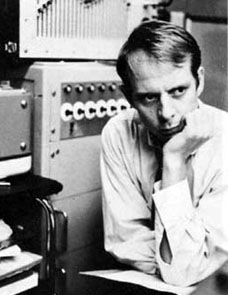| Karlheinz Stockhausen  Born: 22-Aug-1928 Born: 22-Aug-1928
Birthplace: Mödrath, Germany
Died: 5-Dec-2007
Location of death: Kürten, Germany
Cause of death: unspecified
Remains: Buried, Kürten Friedhof, Cologne, Germany
Gender: Male
Religion: Other
Race or Ethnicity: White
Sexual orientation: Straight
Occupation: Composer Nationality: Germany
Executive summary: Influential avant-garde composer Born in the town of Mödrath, located near Cologne, Karlheinz Stockhausen's early life was marred by the violence brought about by the Nazi uprising and the extensive bombing of Germany during World War II. By the end of the war he had lost both his parents -- his father a casualty of the fighting, and his mother executed by Nazi authorities during their purges of mental institutions -- and had himself been forced to endure the horrors of modern warfare as a stretcher-bearer for a field military hospital. As he embarked on a serious study of music, these experiences motivated his rejection of what he and his peers considered the obsolete criteria of Romanticism in favor of finding a new approach that more accurately reflected the world around him.
Following the conclusion of the war Stockhausen returned to Cologne, working various sustenance jobs and playing piano in local bars. Between 1947 and 1951 he attended the Cologne Musikhochschule, but it was his attendance at Darmstadt (1951) and the subsequent years studying under Olivier Messiaen at the Paris Conservatoire that had the most significant impact upon his musical development. During this period he began his exploration of serialism and made his first ventures into electronic music -- the former first realized in 1951's piano-oriented Kreuzspiel and followed by KontraPunkte in 1952. Although he achieved some recognition with these earlier works, the piece that fully established his reputation on an international scale was the 1956 magnetic tape composition Gesang der Jünglinge, created after the completion of his studies in Paris. This reputation was further reinforced the following year by the three-orchestra composition Gruppen, which elaborated the processes of serialism beyond its pointilistic approach, and by his extensive texts and lectures on music theory.
With his first trip to the States in 1958, Stockhausen made the acquaintance of American composer John Cage -- an association that was to have a noticeable impact upon his subsequent work. Having begun to explore aleatoric/statistical procedures during his studies with physicist Werner Meyer-Eppler in 1954, Cage's utilization of chance operations in composition further reinforced Stockhausen's own interest in these methods, as was reflected in pieces such as Carré (for four orchestras and choirs, 1960) and Kontakte (for piano, percussion and magnetic tape, also 1960). For Carré Stockhausen also enlisted the participation of British avant-garde composer Cornelius Cardew, who later published an article titled Stockhausen Serves Imperialism to critique the fact that the composer continued to maintain a dominant role over the individual players performing his works.
During the 1960s Stockhausen became active in the Fluxus art/performance movement, as well as creating his own "Stockhausen Group", which would perform on primarily electronic devices in response to diagrams or text pieces rather than conventional scores. Inspired by a visit to Japan, his works later in the decade focused on the integration of sounds from various cultures, beginning with the primarily Eastern/African blend of Telemusik (1966) and culminating in the national-anthem montage Hymnen (1967). It was in Japan (at the Osaka World Expo) that the first major retrospective of Stockhausen's music was presented in 1970, utilizing a spherical auditorium designed by the composer specifically for the event and featuring performances of most of his existing works. 1970 also saw a return to more instrument-based compositions, initiated by the piano-and-electronics interplay of Mantra (1970), and continued with Trans, Inori (1974) and Sirius (1977).
After 1977 the majority of Stockhausen's output was in connection with his massive opera-cycle Licht, consisting of a performance for each of the 7 days in the week. The work -- finally completed in December of 2002 and clocking in at nearly 30 hours of material -- has yet to be presented in its entirety, but numerous excerpts from most of the days have been staged around the world since 1981. One of the most unusual sections of Licht, Helikopter Streichquartett (premiered in 1993), required the four string players to perform in helicopters while audio and video of their performance was broadcast to the audience in the hall below.
Unfortunately, most of Stockhausen's notoriety in the '00s was due not to his creative output, but to a piece of media slander attributed to him shortly after the terrorist attacks in New York City in 2001. Having stated at a press conference that he believed the Devil was still an active force in the world and that the destruction of the World Trade Center was his greatest work of art, a German newspaper subsequently twisted the quote to make it appear that Stockhausen had simply considered the event "a great work of art". The false quote was eagerly carried along by the international media, but the later correction was largely ignored. Father: Simon Stockhausen (teacher, d. 1944)
Mother: Gertrude (d. 1941)
Wife: Doris (div.)
Wife: Mary Bauermeister (painter, m. 1967, div.)
Son: Markus Stockhausen (trumpeter)
Daughter: Majella Stockhausen (pianist)
Son: Simon Stockhausen (composer/musician)
Girlfriend: Suzanne Stephens (clarinettist)
Girlfriend: Kathinka Pasveer (flautist)
University: Cologne Musikhochschule, Germany (1947-51)
University: Darmstadt (1951)
University: Paris Conservatoire (1951-53)
University: University of Bonn (1954-56)
Karlheinz Stockhausen
Polar Music Prize 2001
Official Website:
http://www.stockhausen.org/
Requires Flash 7+ and Javascript.
Do you know something we don't?
Submit a correction or make a comment about this profile
Copyright ©2019 Soylent Communications
|